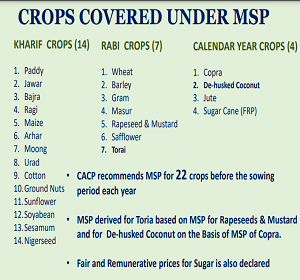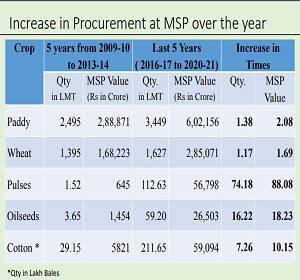Agricultural Price Policy in India: The primary goal of Indian agricultural policy is to maintain a reasonable link between agricultural grain prices and non-food grain prices, as well as between agricultural commodities so that the terms of trade between the aforementioned areas of the economy do not deteriorate dramatically.
Agricultural Price Policy in India has been developed by the government for agricultural products to ensure that farmers receive fair prices to encourage or motivate them to spend more on agriculture. Keeping in mind, the government announces Minimum Support Prices (MSP) for major agricultural products every year. The government provides food grains to the BPL families through the public distribution system. These prices are fixed after consulting the Commission for Agricultural Costs and Prices (CACP).
The initial price policy at the dawn of Independence was, to a large extent, based on the plethora of controls exercised during the Second World War. It included rigid controls on the movement of crops from one State to the other, procurement of food grains through a compulsory levy on producers and millers, open market purchases, and rationing in practically all the States. Following the recommendation of the Foodgrains Policy Committee of 1947 for progressive decontrol, restrictions were relaxed. However, a food crisis appeared in 1948, and food prices rose substantially. Accordingly, controls were introduced.
On the recommendations of the Foodgrains Enquiry Committee, 1957, calling for 'social control over the wholesale trade in food grains' and its subsequent endorsement by the National Development Council in November 1958, the Government of India experimented with State trading in food grains in April 1959. According to this scheme, state trading was to be confined to two main commodities - wheat and rice. However, the scheme ran into difficulties since it was put into practice in a haphazard way without taking cognizance of economic forces.' For instance, procurement prices for wheat were fixed at much lower levels than those dictated by the forces of demand and supply.
The Commission of Agricultural Costs and Prices (CACP) while recommending prices takes into account important factors, such as:
I. Cost of production
II. Changes in input prices
III. Input/output Price Parity
IV. Trends in market prices
V. Inter-crop Price Parity
VI. Demand and supply situation
VII. Effect on Industrial Cost Structure
VIII. Effect on the general price level
IX. Effect on the cost of living
X. International market price situation
XI. Parity between prices paid and prices received by farmers (Terms of Trade)
Take a look at the Minimum Support Price 2021-22


Source: static.pib.gov.in
Motives (advantages) behind the announcement of Minimum Support Price (MSP):
To secure the interests of the farmers as also the need of self-reliance, the government has been announcing the minimum support price for 24 major crops. The main objectives f the MSP are:
I. To prevent fall in the price in the situation of over production.
II. To protect the interests of the farmers by ensuring them a minimum price for their crops in the situation of a price fall in the market.
III. To meet the domestic consumption requirement
IV. To provide price stability in the agricultural product
V. To ensure a reasonable relationship between prices of agricultural commodities and manufactured goods
VI. To remove the price difference between two regions or the whole country.
VII. To increase the production and exports of agricultural produce.
VIII. To provide raw materials to the different industries at reasonable prices in the whole country.
Disadvantages of the Minimum Support Price:
I. To increase the income of the farmers, the poor of the country have to pay more. This practice will create the problem to allocate inefficiency in the country.
II. Subsidizing farmers through higher product prices is an inefficient method because it penalizes the consumer with higher prices. Also, it means large farmers will benefit the most. They have received more than they need but small farmers are still struggling.
III. Farmers use fertilizers in huge quantities to increase their production but it creates problems for those people who do not get benefits from this increment in production.
Conclusion: The basic motive behind the Agriculture policy of the Government of India is to save the interests of both farmers and consumers. The prices of the food grains should be decided very wisely so that neither farmers nor consumers get to suffer.
Comments
All Comments (0)
Join the conversation